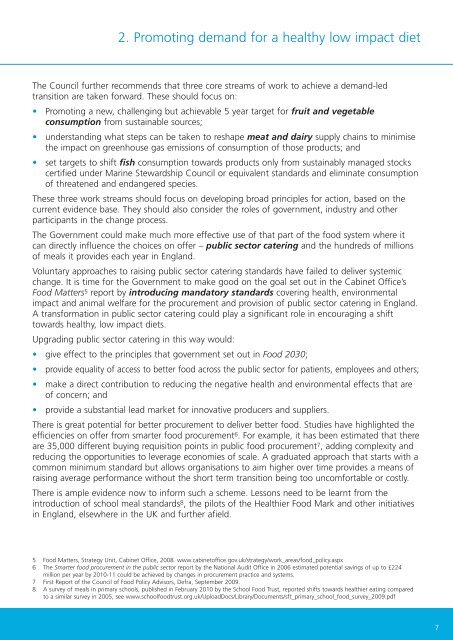Food: a recipe for a healthy, sustainable and successful future
Food: a recipe for a healthy, sustainable and successful future
Food: a recipe for a healthy, sustainable and successful future
Create successful ePaper yourself
Turn your PDF publications into a flip-book with our unique Google optimized e-Paper software.
2. Promoting dem<strong>and</strong> <strong>for</strong> a <strong>healthy</strong> low impact diet<br />
The Council further recommends that three core streams of work to achieve a dem<strong>and</strong>-led<br />
transition are taken <strong>for</strong>ward. These should focus on:<br />
• Promoting a new, challenging but achievable 5 year target <strong>for</strong> fruit <strong>and</strong> vegetable<br />
consumption from <strong>sustainable</strong> sources;<br />
• underst<strong>and</strong>ing what steps can be taken to reshape meat <strong>and</strong> dairy supply chains to minimise<br />
the impact on greenhouse gas emissions of consumption of those products; <strong>and</strong><br />
• set targets to shift fish consumption towards products only from sustainably managed stocks<br />
certified under Marine Stewardship Council or equivalent st<strong>and</strong>ards <strong>and</strong> eliminate consumption<br />
of threatened <strong>and</strong> endangered species.<br />
These three work streams should focus on developing broad principles <strong>for</strong> action, based on the<br />
current evidence base. They should also consider the roles of government, industry <strong>and</strong> other<br />
participants in the change process.<br />
The Government could make much more effective use of that part of the food system where it<br />
can directly influence the choices on offer – public sector catering <strong>and</strong> the hundreds of millions<br />
of meals it provides each year in Engl<strong>and</strong>.<br />
Voluntary approaches to raising public sector catering st<strong>and</strong>ards have failed to deliver systemic<br />
change. It is time <strong>for</strong> the Government to make good on the goal set out in the Cabinet Office’s<br />
<strong>Food</strong> Matters 5 report by introducing m<strong>and</strong>atory st<strong>and</strong>ards covering health, environmental<br />
impact <strong>and</strong> animal welfare <strong>for</strong> the procurement <strong>and</strong> provision of public sector catering in Engl<strong>and</strong>.<br />
A trans<strong>for</strong>mation in public sector catering could play a significant role in encouraging a shift<br />
towards <strong>healthy</strong>, low impact diets.<br />
Upgrading public sector catering in this way would:<br />
• give effect to the principles that government set out in <strong>Food</strong> 2030;<br />
• provide equality of access to better food across the public sector <strong>for</strong> patients, employees <strong>and</strong> others;<br />
• make a direct contribution to reducing the negative health <strong>and</strong> environmental effects that are<br />
of concern; <strong>and</strong><br />
• provide a substantial lead market <strong>for</strong> innovative producers <strong>and</strong> suppliers.<br />
There is great potential <strong>for</strong> better procurement to deliver better food. Studies have highlighted the<br />
efficiencies on offer from smarter food procurement 6 . For example, it has been estimated that there<br />
are 35,000 different buying requisition points in public food procurement 7 , adding complexity <strong>and</strong><br />
reducing the opportunities to leverage economies of scale. A graduated approach that starts with a<br />
common minimum st<strong>and</strong>ard but allows organisations to aim higher over time provides a means of<br />
raising average per<strong>for</strong>mance without the short term transition being too uncom<strong>for</strong>table or costly.<br />
There is ample evidence now to in<strong>for</strong>m such a scheme. Lessons need to be learnt from the<br />
introduction of school meal st<strong>and</strong>ards 8 , the pilots of the Healthier <strong>Food</strong> Mark <strong>and</strong> other initiatives<br />
in Engl<strong>and</strong>, elsewhere in the UK <strong>and</strong> further afield.<br />
5 <strong>Food</strong> Matters, Strategy Unit, Cabinet Office, 2008. www.cabinetoffice.gov.uk/strategy/work_areas/food_policy.aspx<br />
6 The Smarter food procurement in the public sector report by the National Audit Office in 2006 estimated potential savings of up to £224<br />
million per year by 2010-11 could be achieved by changes in procurement practice <strong>and</strong> systems.<br />
7 First Report of the Council of <strong>Food</strong> Policy Advisors, Defra, September 2009.<br />
8 A survey of meals in primary schools, published in February 2010 by the School <strong>Food</strong> Trust, reported shifts towards healthier eating compared<br />
to a similar survey in 2005, see www.schoolfoodtrust.org.uk/UploadDocs/Library/Documents/sft_primary_school_food_survey_2009.pdf<br />
7








